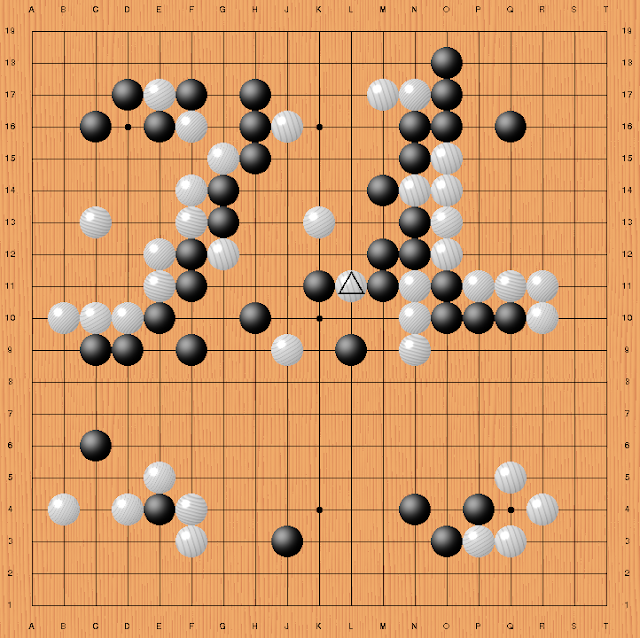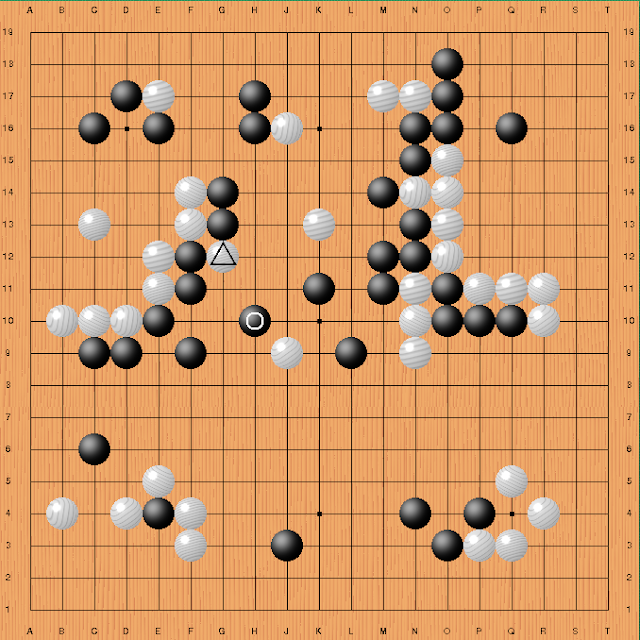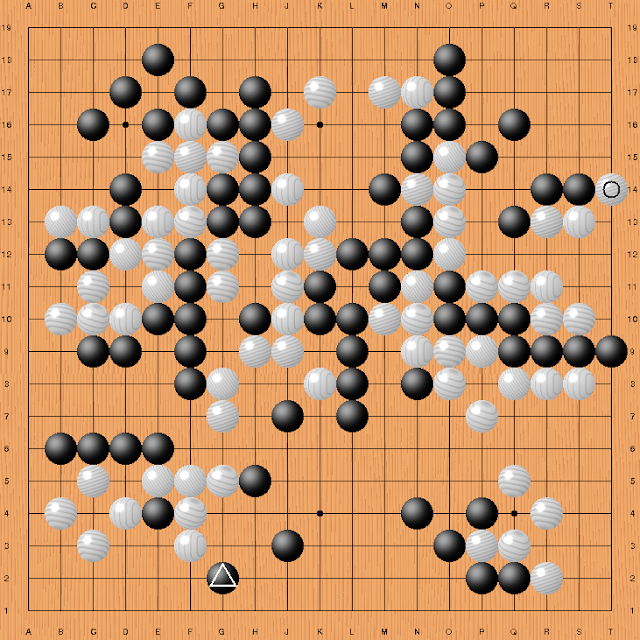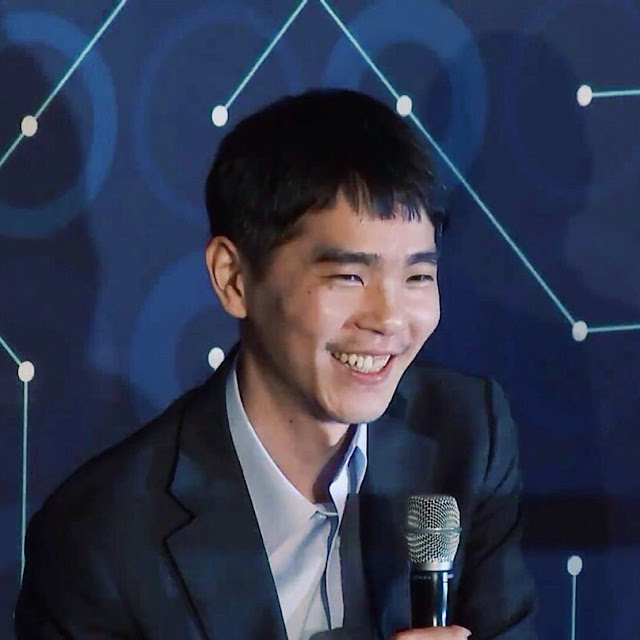After Lee Sedol went under in the match against AlphaGo with three successive losses, and after his mental succumb under incredibly high psychological pressure yet early in the third game, the main question is what Lee Sedol still has up his sleeve when trying to defeat AlphaGo.
And how unimaginable resilient, persistent, and believing in himself Lee Sedol must be, after the new sledgehammer blow of the third game, to try to collect himself, to show that he is able to deliver, and to prove all humanity is right?
And how unimaginable resilient, persistent, and believing in himself Lee Sedol must be, after the new sledgehammer blow of the third game, to try to collect himself, to show that he is able to deliver, and to prove all humanity is right?
The opening of the fourth game is the same as that of the second game (in which Lee Sedol had white also) up to move 12. Lee Sedol response to AlphaGo's probe move (yosu-miru) in the bottom left corner is aggressive (triangle in Dia. 1), attacking both the black stone on the left and black's probing move.
Lee Sedol forces AlphaGo to make a choice but the program simply plays somewhere else (tenuki, circle in Dia. 1). With a shoulder hit black first wants to see how things develop in this area before deciding how to answer white's double offensive (triangle in Dia. 1).
 |
Dia. 1: Game 4, after black 25 (circle, Lee Sedol is white) |
Lee Sedol concentrates on taking territory in the edges and bottom corners while AlphaGo conquers the upper side and builds influence in the center (Dia. 2). Lee Sedol follows the amashi strategy: the amashi player takes territory in exchange for influence, and hopes to withstand the outside power and attacks later.
 |
Dia. 3: Game 4, after black 47 (circle, Lee Sedol is white) |
Since multiple important and large-scale fights make it much harder for AlphaGo to judge the board position correctly, these are the ideal and complex battles to initiate for Lee Sedol.
Where to play next, is a matter of 'looking' forward at least 20-25 moves in this ambiguous fight in the center and right edge. Lee Sedol's fabulous intuition and immense skills in assessing all options and starting points in such explosive positions, are herewith invaluable (Dia. 4). Both AlphaGo and Lee Sedol have to rely on a very crude estimate of how the position may develop gradually.
Where to play next, is a matter of 'looking' forward at least 20-25 moves in this ambiguous fight in the center and right edge. Lee Sedol's fabulous intuition and immense skills in assessing all options and starting points in such explosive positions, are herewith invaluable (Dia. 4). Both AlphaGo and Lee Sedol have to rely on a very crude estimate of how the position may develop gradually.
Black decides to leave his stones at the middle right hand side and further strengthens his moyo to increase the pressure on white to the very maximum. For Lee Sedol it seems virtually impossible to do something sensible with his center stones. After he cuts to make the position more complex (triangle in Dia. 5), AlphaGo answers confidently and seals off any escape routes towards the center (circle in Dia. 5).
Although black has substantial weaknesses at both moyo edges, the white center stones appear to cooperate rather loosely and creating a living group is there out of the question. Also, to escape is not an option for white with such a majority of black stones awaiting him (center and bottom). Moreover, the aji of black's group in the middle right complicates an eventual white escape (Dia. 5).
In short, it looks like this once more will be a major victory for AlphaGo: white's position seems completely hopeless. But then Lee Sedol puts forward a completely unexpected, wonderful, and brilliant move that suddenly sets the entire board on fire. All white center stones are activated at once and do cooperate effectively by exploiting the aji in black's center moyo in all conceivable means (Dia. 6).
In short, it looks like this once more will be a major victory for AlphaGo: white's position seems completely hopeless. But then Lee Sedol puts forward a completely unexpected, wonderful, and brilliant move that suddenly sets the entire board on fire. All white center stones are activated at once and do cooperate effectively by exploiting the aji in black's center moyo in all conceivable means (Dia. 6).
Lee Sedol's move just dropped out of the sky, both for all live commentators and the many top Go-profs that closely followed the game. It unites all Lee Sedol's power, skills, perseverance, creativity, intuition, willingness to fight and to seek reprisal for all frustration and powerlessness in the previous three games. When seeing this move during the live commentary in China, top Go-prof Gu Li (9p) described Lee Sedol's move 78 (triangle in Dia. 6) as a "God's move".
With black 79, AlphaGo fails to play the best response and what happens is a sequence of moves that the program calculated as the strongest answers. In exchange for it's group lost on the right, AlphaGo just gets a poor sente move that the program also could have played immediately (Q13 in Dia. 7).
With black 79, AlphaGo fails to play the best response and what happens is a sequence of moves that the program calculated as the strongest answers. In exchange for it's group lost on the right, AlphaGo just gets a poor sente move that the program also could have played immediately (Q13 in Dia. 7).
Commentator Michael Redmond (9p) showed that instead of black 79 much better responses were possible than AlphaGo actually played in the game. In the end, AlphaGo has to give up the stones in the middle right, so that Lee Sedol not only has secured his group and largely destroyed black's center moyo but in addition cashed in a pile of points on the right.
With move 110 (circle in Dia. 8), white secures his relatively weak stones in the center by attacking the black group on the left (center). In this manner, white creates enough options to connect with the group in the bottom left in case of emergency.
Direct comparison of Dia. 7 and --more than thirty moves later-- Dia. 8 immediately demonstrates that white has achieved the unimaginable: it is as if white's invading center stones were able to escape through an invisible tunnel (David Ormerod). Lee Sedol efficiently utilized the aji in black's center that he correctly estimated 25 moves earlier.
With move 110 (circle in Dia. 8), white secures his relatively weak stones in the center by attacking the black group on the left (center). In this manner, white creates enough options to connect with the group in the bottom left in case of emergency.
Direct comparison of Dia. 7 and --more than thirty moves later-- Dia. 8 immediately demonstrates that white has achieved the unimaginable: it is as if white's invading center stones were able to escape through an invisible tunnel (David Ormerod). Lee Sedol efficiently utilized the aji in black's center that he correctly estimated 25 moves earlier.
With this successful center fight, Lee Sedol takes a clear lead. The South Korean live commentators cannot hide their excitement when it becomes clear that Lee Sedol --after three hours into the game-- probably will notch a win.
There is nothing left to AlphaGo other than to secure it's group on the middle left and to allow that Lee Sedol meanwhile connects his center group --in sente--. Then white further erodes black's center by connecting the three white stones on the upper side. Black's entire moyo has been neutralized (Dia. 9).
AlphaGo tries to catch up with active play but Lee Sedol plays magnificently sharp. An example of this is Lee Sedol's counter move in Dia. 9: white ignores black's threat at the bottom right corner and plays a larger counter threat (circle in Dia. 9; that also prevents black's sente moves in this area).
There is nothing left to AlphaGo other than to secure it's group on the middle left and to allow that Lee Sedol meanwhile connects his center group --in sente--. Then white further erodes black's center by connecting the three white stones on the upper side. Black's entire moyo has been neutralized (Dia. 9).
AlphaGo tries to catch up with active play but Lee Sedol plays magnificently sharp. An example of this is Lee Sedol's counter move in Dia. 9: white ignores black's threat at the bottom right corner and plays a larger counter threat (circle in Dia. 9; that also prevents black's sente moves in this area).
About twenty moves later, AlphaGo threatens with a pointless dame point to cut off white's meanwhile large center group (triangle in Dia. 11). In response, Lee Sedol plays a big endgame move settling his group at the same time (circle in Dia. 11). If AlphaGo would have played here first, the program would have gained several points --in sente--. Thus, with this move (triangle in Dia. 11) AlphaGo in fact resigns.
 |
Dia. 11: Game 4, after white 168 (circle, Lee Sedol is white). |
Obviously, AlphaGo's logic is not optimal anymore at all since it plays many forcing moves generated by the meager potential that the opponent might make a mistake (Michael Redmond). After playing a handful of doubtful moves and several mistakes that even lost additional points, AlphaGo resigned (Dia. 12).
Dia. 12 shows the final position after Lee Sedol's move 180, nearly five hours into the game, at which AlphaGo resigned after it's notion that the probabilities of winning this game were falling below it's critical threshold of 10% for resignation. At this point, AlphaGo is behind at least 5 points (komi included) and therefore needs to make more than ~20 points in the bottom center area (without Lee Sedol getting any compensation for that) in order to catch up.
Even though Lee Sedol played under ultra-high pressure for more than one hour (from move 90 on), using his last byo-yomi period up to the max each move, he was able to maintain and solidify his advantage built up in the middle game. This is the first time that AlphaGo lost a game against a top professional Go player (in the official match games without handicap). Lee Sedol's great victory is an extraordinary and historic achievement which has led to the deepest respect and admiration from all over the world.
Even though Lee Sedol played under ultra-high pressure for more than one hour (from move 90 on), using his last byo-yomi period up to the max each move, he was able to maintain and solidify his advantage built up in the middle game. This is the first time that AlphaGo lost a game against a top professional Go player (in the official match games without handicap). Lee Sedol's great victory is an extraordinary and historic achievement which has led to the deepest respect and admiration from all over the world.
A Korean Go-pro stated: "Lee Sedol just fought the 1000 years history of Baduk and I am proud of him". An Younggil (8p) concluded that the game was "a masterpiece for Lee Sedol and will almost certainly become a famous game in the history of Go".
Lee Sedol's win against AlphaGo shows --and does prove for the first time-- that deep learning AlphaGo does not play perfect all the time and sometimes has severe problems in judging correctly complex middle game positions. Despite the considerable pressure, Lee Sedol could play his own game and exposed a clear glimpse of AlphaGo's weaknesses.
During the press conference afterwards, the public and press were wild with enthusiasm and chanted: “Lee Sedol!” ”Lee Sedol!” “Lee Sedol!”. Several minutes flashing recorded a radiant, visibly overjoyed and genuinely pleased Lee Sedol: "I have never been congratulated so much just because I won one game. Winning this game is still valuable, the drive behind the win today is the trust and the compassion of you all. This one win is so valuable and I will not trade this for anything in the world".
And asked what Lee Sedol was thinking when he was played his brilliant move (move 78, Dia. 6): "I thought I would be able to gain some profit quite easily but that wasn't the case. It became more difficult than I had expected and at that point in time, at time of 78th move, that was the only move that I could see, there were no other moves, no other placement that I could think of. That was the only place I could place my stone, it was the only option for me, so I put it there. So I am quite humble for all the praise that I'm getting for that".
Demis Hassabis said: "AlphaGo made a mistake around move 79 but it realized it's mistake only after the 87th move, when it was too late to recover from. AlphaGo thought it was doing very well at the start of the complex center fight but was pressured by Lee Sedol in some mistakes. It is because of the incredible fighting spirit Lee Sedol showed that a creative genius like him is able to find out and exploit any weakness of AlphaGo. The loss by AlphaGo is very valuable: we will look at all the statistics and are looking forward to learn from these weaknesses and fix these problems".
David Silver, Google DeepMind's team leader, added: "We have designed AlphaGo to learn by itself by repeating self-plays. But such an algorithm must have holes in it that we cannot know about. Lee was able to push AlphaGo to expose such a weakness".
Lee Sedol concluded: "I believe AlphaGo has two weaknesses: when I made an unexpected move, AlphaGo responded as if the program had a bug, indicating that the machine lacked the ability to deal with surprises. Furthermore, AlphaGo finds it more difficult to win the game when it has black as opposed to when it has white. Therefore, I would like to ask Demis Hassabis and David Silver: 'would it be possible for me to take black in the last game instead of drawing lots?'". The answer was: "yes, it's fine".
This fourth game of the match was decided by Lee Sedol's profound and fabulous move in a complex middle game fight that forced deep learning AlphaGo to a sequence of mistakes. After this, the game was completely turned around and AlphaGo was unable to defend against all weaknesses exposed in it's center position. After three successive losses against the program, this game Lee Sedol clearly outperformed AlphaGo for the first time: a great and historic achievement by Lee Sedol.
[Part 6: Review of Game 1: Lee Sedol underestimates AlphaGo's incredible fighting power]
[Part 7: Review of Game 2: AlphaGo's new move and devastating aggression]
[Part 8: Review of Game 3: Lee Sedol's opening mistakes due to enormous mental pressure]
[Part 10: Review of Game 5: AlphaGo unfamiliar with common tesuji in ultimate moyo game]
This fourth game of the match was decided by Lee Sedol's profound and fabulous move in a complex middle game fight that forced deep learning AlphaGo to a sequence of mistakes. After this, the game was completely turned around and AlphaGo was unable to defend against all weaknesses exposed in it's center position. After three successive losses against the program, this game Lee Sedol clearly outperformed AlphaGo for the first time: a great and historic achievement by Lee Sedol.
[Part 6: Review of Game 1: Lee Sedol underestimates AlphaGo's incredible fighting power]
[Part 8: Review of Game 3: Lee Sedol's opening mistakes due to enormous mental pressure]
[Part 10: Review of Game 5: AlphaGo unfamiliar with common tesuji in ultimate moyo game]




















Review of Game 4: Lee Sedol's brilliant move reveals weaknesses AlphaGo
ReplyDeleteThis review of the fourth game of the Google DeepMind challenging match between deep learning AlphaGo and top Go-prof Lee Sedol (9p) is a highlighting game commentary and analysis including short explanations and discussions of the most important moves and positions, many diagrams, images of the match, and commentaries by top Go-profs and Lee Sedol himself.
How powerless must it be for Lee Sedol to lose a match against a computer program in such an unsparing manner, while hundreds of millions worldwide regarded him as fighting on behalf of all of humanity and had mega high hopes of him?
Lee Sedol's first win against AlphaGo shows --and does prove for the first time-- that deep learning AlphaGo is not playing perfect all the time and sometimes really experiences some severe problems in judging correctly the outcome of a rather complex middle-game fight with multiple fights at the same time. Despite the tremendous pressure Lee Sedol could play his own game and clearly expose a glimpse of AlphaGo's weaknesses.
The crowd was really delirious with exultation and chanted: “Lee Sedol!” ”Lee Sedol!” “Lee Sedol!” during the press conference afterwards. Minutes- long flashing recorded an upbeat, radiant, visibly overjoyed and genuinely pleased Lee Sedol. His first reaction was: "I have never been congratulated so much just because I won one game. Winning this game is so precious, the drive behind the win today is the trust and the compassion of you all. This one win is so valuable and I will not trade this for anything in the world".
Part 9 of "The historic match of deep learning AlphaGo vs. Lee Sedol'
Baduk is a philosophy game and grows wisdom in the players. This is really an exceptional game it the modern sports arena. The game is now well popularized in many countries but I think Korea is advanced enough than others. Really love this wonderful stuff. This was a fantastic travel to this site and was able to learn something regarding the baduk game and player. I enjoyed the challenging win of Lee Sedol with Alpha go. Thanks for sharing the sporting information. Simply I the way the author disclosed the whole details. 바둑이사이트
ReplyDelete